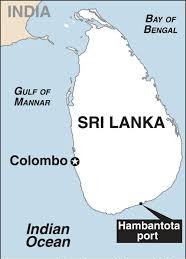Context:
- Hambantota port is located right in middle of vital energy supply lines in Indian Ocean, connecting Middle East and East Asia.
- Sri Lanka has signed a US $1.1 billion deal to sell a 70% stake of the strategic Hambantota deep-sea port to China.
- Hambantota port is a deep-water port in the southern tip of Sri Lanka.
- Under the 99-year lease agreement, China will invest up to US $1.1 billion in the port and marine-related activities.
- The deal had fanned concerns of countries with competing strategic interests with China, particularly India and US.
- Local residents of Hambantota are also protesting selling of “national assets to foreign entities” leading to violent clashes.

Advantages to China:
- The port is expected to play a key role in China’s Belt and Road initiative (BRI), which will link ports and roads between China and Europe.
- It is also considered that, this deal gives an advantage to China in the bunkering business, which provides fuel to ships.
Disadvantages to India:
- India is apprehensive that the port is part of Chinese ‘string of pearls’ with an objective to surround India and dock its military vessels.
- The String of pearls is a geopolitical theory on potential Chinese intentions in the Indian Ocean region.
- It refers to the network of Chinese military and commercial facilities and relationships along its sea lines of communication extending from the Chinese mainland to Port Sudan.
- These sea lines run through several major maritime choke points such as the Strait of Mandeb, Strait of Hormuz, Strait of Malacca and the Lombok Strait as well as other strategic maritime centres in Pakistan, Maldives, Sri Lanka, Bangladesh, and Somalia.
India’s housing project:
Sri Lanka has signed Memorandum of Understanding (MoU) with India to build 1,200 houses in strategically located southern port city of Hambantota.
Hambantota : A Failing port and China’s strategy
-
Every time Sri Lanka’s President, Mahinda Rajapaksa, turned to his Chinese allies for loans and assistance with an ambitious port project, the answer was yes, though feasibility studies said the port wouldn’t work.
-
The other frequent lenders like India had refused and Sri Lanka’s debt was ballooning rapidly under Mr. Rajapaksa.
-
With tens of thousands of ships passing by along one of the world’s busiest shipping lanes, the port drew only 34 ships in 2012. And then the port became China’s.
-
The transfer gave China control of territory just a few hundred miles off the shores of a rival, India, and a strategic foothold along a critical commercial and military waterway.
-
The debt deal also intensified some of the harshest accusations about President Xi Jinping’s signature Belt and Road Initiative: that the global investment and lending programme amounts to a debt trap for vulnerable countries around the world, fuelling corruption and autocratic behaviour in struggling democracies.
-
During the 2015 Sri Lankan elections, large payments from the Chinese port construction fund flowed directly to campaign aides and activities for Mr. Rajapaksa, who had agreed to Chinese terms at every turn and was seen as an important ally in China’s efforts to tilt influence away from India in South Asia.
-
Though Chinese officials and analysts have insisted that China’s interest in the Hambantota port is purely commercial, Sri Lankan officials said that from the start, the intelligence and strategic possibilities of the port’s location were part of the negotiations.
-
Indian officials, in particular, fear that Sri Lanka is struggling so much that the Chinese government may be able to dangle debt relief in exchange for its military’s use of assets like the Hambantota port — though the final lease agreement with China forbids military activity there without Sri Lanka’s invitation.